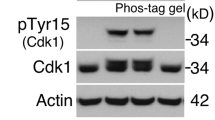Abstract
We have cloned a mousewee1 kinase cDNA (mwee1). The clone is 2258 bp in length and its open reading frame corresponds to 646 amino acid residues. The molecular weight of this kinase is 87 kDa in SDS-PAGE, which is about 1.7-fold larger than the human p50wee1 kinase reported previously. In a cell cycle, the mousewee1 kinase is phosphorylated at M-phase, and anin vitro study using a mitotic extract revealed that phosphorylation occurs in the N-terminal domain, which is absent from the humanwee1 kinase, resulting in inactivation of the kinase activity. The N-terminal domain or entire molecule is extensively phosphorylated bycdc2-cyclin B kinase. Furthermore, the activity of thewee1 kinase was reduced by phosphorylation with the mitotic extract which containedcdc2-cyclin B kinase
Similar content being viewed by others
References
Booher RN, Dashaies RJ, Kirschner MW (1993) Properties ofSaccharomyces cerevisiae wee1 and its differential regulation of p34CDC28 in response to G1 and G2 cyclines.EMBO J 12: 3417–3426
Coleman TR, Tang Z, Dunphy WG (1993) Negative regulation of the wee1 protein kinase by direct action of the Nim/Cdr1 mitotic inducer.Cell 72: 919–929.
Dunphy WG, Kumagai A (1991) The cdc25 protein contains an intrinsic phosphatase activity.Cell 67: 189–196.
Featherstone C, Russell P (1991) Fission yeast p107wee1 mitotic inhibitor is a tyrosine/serine kinase.Nature 349 808–811.
Fesquet D, Labbe J-C, Derancourtet al. (1993) The MO15 gene encodes the catalytic subunit of a protein kinase that activates cdc2 and other cyclin-dependent kinases (CDKs) through phosphorylation of Thr161 and its homologues.EMBO J 12: 3111–3121.
Gould KL, Nurse P (1989) Tyrosine phosphorylation of the fission yeast cdc2+ protein kinase regulates entry into mitosis.Nature 342: 39–45.
Hoffmann I, Clarke PR, Marcote MJ, Karsenti E, Draetta G (1993) Phosphorylation and activation of human cdc25-C by cdc2-cyclin B and its involvement in the self-amplification.EMBO J 12: 53–63.
Honda R, Ohba Y, Yasuda H (1992) The cell cycle regulator, human p50wee1, is a tyrosine kinase and not a serine/tyrosine kinase.Biochem Biophys Res Commun 186: 1333–1338.
Honda R, Ohba Y, Nagata A, Okayama H, Yasuda H (1993) Dephosphorylation of human p34cdc2 kinase on both Thr-14 and Tyr-15 by human cdc25B phosphatase.FEBS Lett 318: 331–334.
Igarashi M, Nagata A, Jinno S, Suto K, Okayama H (1991) Wee1+-like gene in human cells.Nature 353: 80–83.
Krek W, Nigg EA (1991) Mutations of p34cdc2 phosphorylation site induce premature mitotic events in HeLa cells: evidence for a double block to p34cdc2 kinase activation in vertebrates.EMBO J 10: 3331–3341.
Kasubata M, Tokui T, Matuokaet al. (1992) p13suc1 suppresses the catalytic function of p34cdc2 kinase for intermediate filament proteins,in vitro.J Biol Chem 267: 20937–20942.
Lundgren K, Walworth N, Booher Ret al. (1991) mik1 and wee1 cooperate in the inhibitory tyrosine phosphorylation of cdc2.Cell 64: 1111–1122.
McGowan CH, Russell P (1993) Human wee1 kinase inhibits cell division by phosphorylating p34cdc2 exclusively on Tyr15.EMBO J 12: 75–85.
Norbury C, Nurse P (1991) Regulatory phosphorylation of the p34cdc2 protein kinase in vertebrates.EMBO J 10: 3321–3329.
Norbury C, Nurse P (1992) Animal cell cycles and their control.Annu Rev Biochem 61: 441–470.
Nose K, Saito H, Kuroki T (1990) Isolation of a gene sequence induced later by tumor-promoting 12-O-tetradecanoylphorbol-13-acetate in mouse osteoblastic cells (MC3T3-E1) and expressed constitutively in ras-transformed cells.Cell Growth Different 1: 511–518.
Ohkubo Y, Kishimoto T, Nakata T, Yasuda H, Endo T (1994) SV40 large T antigen reinduces the cell cycle in terminally differentiated myotubes through inducing cdk2, cdc2, and their partner cyclins.Exp Cell Res 214: 270–278.
Parker LL, Piwnica-Worms H (1992) Inactivation of the p34cdc2-cyclin B complex by the human wee1 tyrosine kinase.Science 257: 1955–1957.
Parker LL, Atherton-Fessler S, Lee MSet al. (1991) Cyclin promotes the tyrosine phosphorylation of p34cdc2 in a wee1+ dependent manner.EMBO J 10: 1255–1263.
Parker LL, Atherton-Fessler S, Piwnica-Worms H (1992) p107wee1 is a dual-specificity kinase that phosphorylates p34cdc2 on tyrosine 15.Proc Natl Acad Sci USA 89: 2917–2921.
Parker LL, Walter SA, Young PG, Piwnica-Worms H (1993) Phosphorylation and inactivation of the mitotic inhibitor Wee1 by thenim1/cdr1 kinase.Nature 363: 736–738.
Poon RY, Yamashita K, Adamczewski JP, Hunt T, Shuttleworth J (1993) The cdc2-related protein p40MO15 is the catalytic subunit of a protein kinase that can activate p33cdk2 and p34cdc2.EMBO J 12: 3123–3132.
Russell P, Nurse P (1987a) Negative regulation of mitosis by wee1+, a gene encoding a protein kinase homolog.Cell 49: 559–567.
Russell P, Nurse P (1987b) The mitosis inducer nim1+ functions in a regulatory network of protein kinase homologs controlling the initiation of mitosis.Cell 49: 569–576.
Solomon MJ, Lee T, Kirschner MW (1992) Role of phosphorylation in p34cdc2 activation: identification of an activating kinase.Mol Biol Cell 3: 13–27.
Solomon MJ, Harper JW, Shuttleworth J (1993) CAK, the p34cdc2 activating kinase, contains a protein identical or closely related to p40MO15.EMBO J 12: 3133–3142.
Strausfeld U, Labbe JC, Fesquet D, Cavadore JC, Picard A, Sadhu K, Russell P, Doree M (1991) Dephosphorylation and activation of a p34cdc2-cyclin B complexin vitro by human cdc25 protein.Nature 351: 242–244.
Tang Z, Coleman TR, Dunphy WG (1993) Two distinct mechanisms for negative regulation of the Wee1 protein kinase.EMBO J 12: 3427–3436.
Wu L, Russell P (1993) Nim1 kinase promotes mitosis by inactivating Wee1 tyrosine kinase.Nature 363: 738–741.
Yasuda H, Kamijo M, Nagahara M, Honda R, Ohba Y (1990) The difference in murine cdc2 kinase activity between cytoplasmic and nuclear fractions during the cell cycle.Biochem Biophys Res Commun 172: 371–376.
Yasuda H, Kamijo M, Honda R, Nakamura M, Hanaoka F, Ohba Y (1991) A point mutation in C-terminal region of cdc2 kinase causes a G2-phase arrest in a mouse temperature-sensitive FM3A cell mutant.Cell Struct Funct 16: 105–112.
Yasuda H, Nakata T, Kamijo M,et al. (1992) Cyclin dependent kinase 2 (cdk2) in the murine cdc2 kinase ts mutant.Somatic Cell Mol Genet 18: 403–408.
Author information
Authors and Affiliations
Rights and permissions
About this article
Cite this article
Honda, R., Tanaka, H., Ohba, Y. et al. Mouse p87wee1 kinase is regulated by M-phase specific phosphorylation. Chromosome Res 3, 300–308 (1995). https://doi.org/10.1007/BF00713068
Received:
Revised:
Accepted:
Issue Date:
DOI: https://doi.org/10.1007/BF00713068




